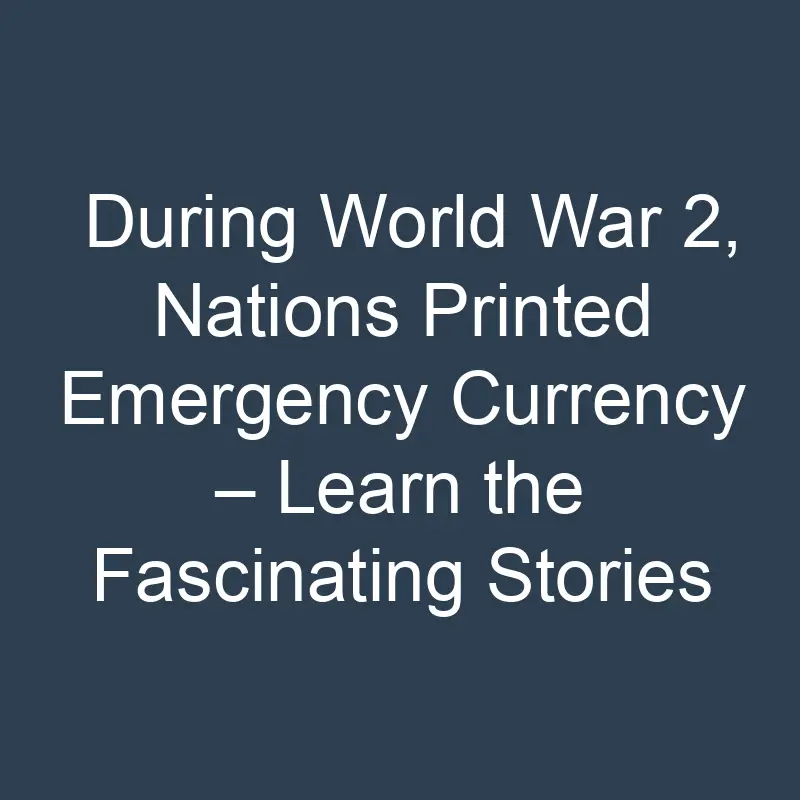
During World War 2, the need for emergency currency became paramount as countries faced economic challenges. The production of emergency currency was a strategic move to ensure financial stability amidst the chaos of war. In this article, we’ll delve into the fascinating world of emergency currency printed during World War 2.
As nations grappled with the repercussions of war, emergency currency played a crucial role in maintaining the flow of money and stabilizing economies. These unique banknotes were often issued as a temporary measure but left a lasting impact on the history of currency. Join us as we explore the stories behind the emergency currency printed during one of the most turbulent times in history.
The Need for Emergency Currency in World War 2
During World War 2, emergency currency was indeed printed by various nations to address the unique financial challenges brought about by the conflict. The massive mobilization of resources for the war effort often resulted in disruptions to the normal functioning of economies, leading to shortages of coins and banknotes. This scarcity required governments to take swift action to ensure that the flow of money continued uninterrupted.
Emergency currency served as a vital tool in maintaining economic stability during this tumultuous period. By quickly producing banknotes in response to the crisis, governments were able to facilitate transactions, pay workers, and meet essential financial needs. These emergency measures were essential for sustaining economic activity and preventing financial collapse in the face of war-induced disruptions.
The issuance of emergency currency was not merely a practical response to a logistical challenge; it also carried symbolic significance. These unique banknotes often featured patriotic motifs or symbols of resilience, reflecting the spirit of unity and determination in times of crisis. By circulating these specially designed banknotes, governments sought to boost morale and convey a sense of national strength in the face of adversity.
In the next section, we will delve deeper into the design and features of emergency currency issued during World War 2, exploring the artistic and historical elements that make these banknotes collector’s items today.
Production of Emergency Currency: A Strategic Move
In times of crisis like World War 2, nations worldwide resorted to printing emergency currency as a strategic move to stabilize their economies. These carefully designed banknotes were not just pieces of paper but vital tools in maintaining financial transactions and averting monetary collapse.
Emergency currency production during World War 2 was a complex process involving meticulous planning and execution. Each nation had to ensure the security features of these banknotes to prevent counterfeiting and maintain public trust in the currency.
Countries like Germany, Japan, the United Kingdom, and the United States were among the many nations that issued emergency currency during the war. These banknotes served as a temporary solution to the shortage of regular currency caused by the upheaval in financial systems due to the war.
The production of emergency currency was not just a practical measure but also a symbolic one, showcasing a nation’s resilience in the face of adversity. These unique banknotes often featured patriotic symbols and historical references, instilling a sense of national pride and unity during challenging times.
Role of Emergency Currency in Maintaining Financial Stability
During World War 2, emergency currency played a crucial role in maintaining financial stability for nations grappling with the impact of the conflict. These specially issued banknotes served as a vital tool in addressing shortages of traditional currency, ensuring that essential transactions could continue in the midst of wartime disruptions.
Emergency currency was not merely a stopgap measure but a strategic response to economic challenges brought about by the war. By facilitating transactions and sustaining economic activity, these banknotes helped prevent economic collapse and instability during a time of immense uncertainty.
The production of emergency currency was a testament to the resilience and adaptability of nations facing wartime hardships. Governments devoted significant resources to designing and issuing these banknotes, knowing that financial stability was essential for both the war effort and the well-being of their citizens.
Throughout World War 2, the issuance of emergency currency demonstrated the ingenuity and swift action taken by nations to address unprecedented challenges. These banknotes served as a lifeline for economies under duress, embodying the strength and determination of nations navigating the turbulent waters of war.
Impact of Emergency Currency on Economies
During World War 2, the printing of emergency currency played a crucial role in ensuring the stability of economies amidst the chaos of war. These specially issued banknotes were a lifeline for nations facing currency shortages and disruptions in financial transactions.
Governments invested significant resources in designing and issuing emergency currency to prevent economic collapse, demonstrating their commitment to maintaining stability and essential services during challenging times.
The issuance of emergency currency had a profound impact on local economies, helping to sustain vital transactions, support businesses, and ensure the flow of goods and services even in the midst of warfare.
Stories Behind Emergency Currency Printed During World War 2
During World War 2, emergency currency was printed by various nations to address the acute shortage of money caused by the turmoil of war. Let’s uncover some fascinating stories behind the issuance of this special currency:
- Germany: Reichskreditkassenscheine, emergency banknotes issued by Germany during the war, served as a crucial means of payment. They were issued in different denominations and featured intricate designs to prevent counterfeit.
- United Kingdom: In response to the disruption in regular currency supply, the British government introduced Emergency Issues. These notes bore unique serial numbers and were integral in maintaining the flow of transactions.
- United States: Facing similar challenges, the US government authorized the issuance of Hawaii Emergency Currency after the attack on Pearl Harbor. These notes were easily distinguishable and were used to facilitate local transactions.
- Japan: Japanese-occupied territories saw the introduction of banana money, a term used to describe emergency currency made from banana plants. These notes were a creative solution to the scarcity of traditional currency.
- Occupied Countries: Countries under occupation, such as France and the Netherlands, issued local emergency currency to ensure the continuity of essential services and transactions under challenging circumstances.
The stories behind emergency currency during World War 2 highlight the resourcefulness and adaptability of nations in the face of economic disruptions caused by the conflict. These unique currencies not only symbolize wartime challenges but also stand as a testament to the resilience of populations in maintaining financial systems during times of crisis.
Key Takeaways
- Emergency currency was printed during World War 2 by various nations to address financial challenges brought about by the conflict.
- These unique banknotes played a crucial role in maintaining economic stability by facilitating transactions and preventing financial collapse.
- The production of emergency currency was both a practical and symbolic response, showcasing national resilience through patriotic motifs and historical references.
- Nations strategically printed emergency currency to stabilize their economies, ensuring the security features of these banknotes to prevent counterfeiting.
- Emergency currency issuance demonstrated the ingenuity and swift action taken by governments to sustain economies during wartime hardships.
- The impact of emergency currency was profound, providing a lifeline for nations facing currency shortages and disruptions in financial transactions.
Conclusion
In exploring the emergency currency printed during World War 2, we have uncovered the fascinating narratives of nations grappling with financial crises amidst the chaos of war. From Germany’s Reichskreditkassenscheine to Japan’s banana money, each unique banknote tells a story of resilience and innovation in the face of adversity. These special currencies not only served as a practical solution to the shortage of money but also reflected the ingenuity of nations in maintaining economic stability during turbulent times. The intricate designs and security features of these emergency banknotes were a testament to the determination of countries to safeguard their financial systems. The issuance of emergency currency in World War 2 stands as a poignant reminder of the challenges faced and the remarkable solutions devised to overcome them.






